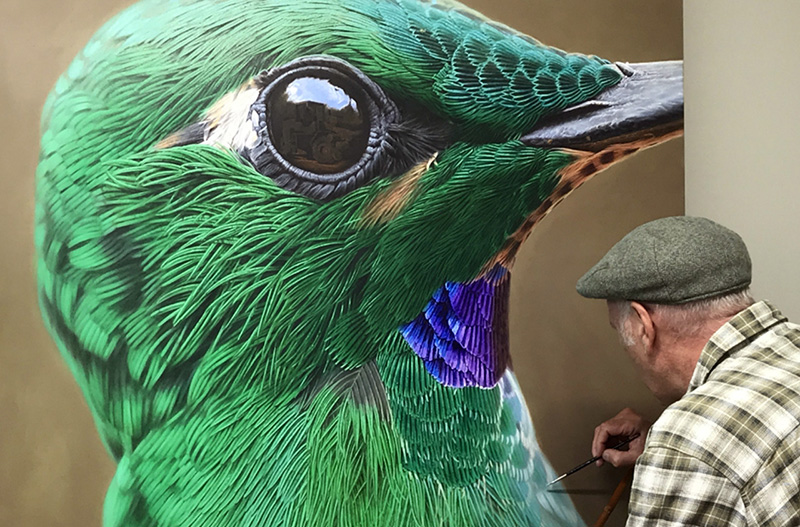
The idea of large hyperrealism bird paintings has been an all consuming interest of mine for over 5 years. I've experimented with paintings of eagles and cockatoos, and although close, I never really thought they achieved true hyperrealism. It occurred to me that the subject needed to be painted at least 30 times lifesize - or if possible, up to 50 times life size to be successful. I believe it is only then that hyperrealism can be fully appreciated. My only real prospect of achieving this was to paint a very small bird, as not many homes or galleries have 3 storey wall hanging space.
Initially I experimented with birds like sparrows and fairywrens only to find that their feathers didn't suit being enlarged to that extent. I needed a bird with feathering that was suited to supersizing so I could engineer a very large hyperrealism painting. Not an easy task! Then one day I saw a macro image of a hummingbird online and knew immediatley I had my subject.
Some hummingbird species look like they have beaks that have been stuck on by a bad taxidermist, others have what I consider to be awkwardly shaped haeads or have monotone head and throat colours. After researching everything on line and in bird books I found the hummingbird species I needed: the Green-crowned Brilliant. A stunning little bird and it's just the right aesthetic shape and colours to please any artist.
The ranges of hummingbirds are strictly defined by altitude and the birds are rarely seen wild in the forest.To get the shots we needed we had to find a lodge with hummingbird feeders located at the correct altitude. It didn't take long to decide on Tandayapa Bird Lodge in Ecuador. Although it was approaching the end of their birding season we were assured that this species occurred in sufficient numbers to get some good reference shots. Not only that, we would have this popular lodge pretty much to ourselves! It sounded ideal, so we booked a weeks accomodation, got our jabs and left.
Before departing I invested in a new macro lens that I knew would capture the minute details I needed. To get the required detail using this lens Nicky and I took turns standing within 30cm (1 foot) of the birds coming into the feeders for 6 hours a day. It was demanding work (although my friends laugh when I say it's work). It was lucky for us that there were no other bird photographers at the lodge, with their huge 600mm lens competing for space around the feeders we would have had a standoff! It took almost 6000 photos to gather just 8 workable images, and even then they had to be slightly modified for use in this huge painting.
'Amazonia' took 3 months to complete, working 6-7 days a week - the longest I have ever spent on an individual piece. So now you understand why I have not posted any blogs recently - I have been totally consumed by this work. During our time away the Amazon rainforEst on the other side of tHe Andes was burning, thus the name we gave this piece. It was indeed ironic that during its creation we were evacuated twice from our own studio and home due to the catastrophic bushfires burning here in Australia.
As a test I posted an image of this painting along with photos we took in Ecuador, and no-one has yet identified there was a painting amongst the photos.....I have lived with this piece or so long I wasn't sure that it was sufficiently photo-real to pass, but I reckon it has. What do you think?